Burning methane¶
This tutorial will help you to:
- create a simple mixture (methane and oxygen)
- set up to burn it quickly (set up your ReaxFF simulation)
- burn it: perform the actual ReaxFF simulation
- visualize what is happening during and after the simulation
- extract a reaction network from the trajectory
Step 2: Create a methane / oxygen mixture¶
Next we will make the methane - oxygen mixture. For full combustion we need at least 2 oxygen molecules for each methane molecule. So we will use 50 methane molecules and 125 oxygen molecules.
- Edit → Builder

The Builder allows you to build your system, and set some things like the cell vectors that define the computation cell.
You can use the Builder to add many molecules, randomly distributed. In the list of molecules to be added the current molecule is already present. If you have any molecules already, the new molecules will be added. Right now we have no molecules yet, so we can remove that entry.
- Click on the - button in front of CurrentClick the + button in front of Molecules once (so now we can specify two kinds of molecules to add)Enter
19on the diagonal to change the box to a cube of 19.0 Angstrom

- Click in the entry field of the first lineType
meto search for methane

As you can see, a search box appears to find your molecule, very similar to the search box in the panel bar.
- Select the Methane (ADF) matchChange the number of molecules to
50Click in the entry field of the second lineTypeoto search for O2Select the O2 (ADF) matchChange the 100 copies of O2 into125copies
You now have specified how the builder should build your system: 50 methane molecules with 125 oxygen molecules added.

At the bottom of the Builder panel you can see that the current density is zero. The new density, after adding methane and oxygen, will be around 1 g/mL, which is obviously very high for this mixture. For this tutorial that is fine as it means things will happen faster.
Next we will actually generate the molecules:
- Click the Generate Molecules button

The molecules are generated at random positions and orientations, with constraint that all atoms (between different molecules) are at least the specified distance (2.5 Angstrom) apart.
The system looks good, we can now close the Builder:
- Click the Close button at the bottom of the Builder window
Step 3: Prepare for burning: set up the simulation¶
The next step is to set up the details of the simulation.
Note
For this tutorial we will perform an MD simulation at very high temperature and density. This is to make things happen quickly. Obviously it is not a realistic system.
- Click the ? on the right side of the Force field line
A new window should appear describing what force fields are available, including a short description and references. For this particular example we will use the CHO force field for hydrocarbon oxidation.
- Close the window describing the force fieldsClick on the folder icon next to Force fieldSelect the CHO.ff force field

Change to the MD settings panel:
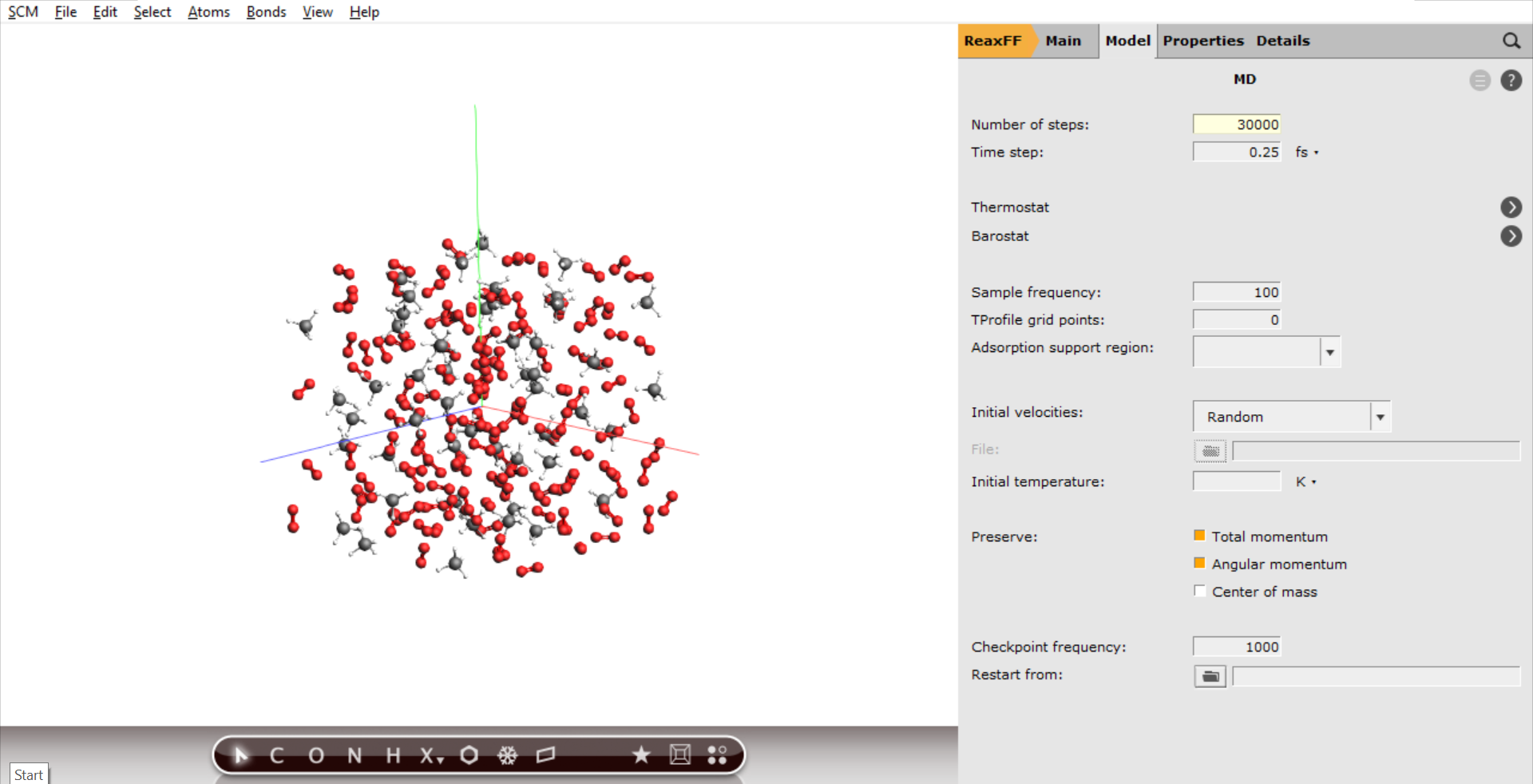
Note
We will be using the Nose-Hoover thermostat which yields better overall sampling results in general. The Nose-Hoover damping constant is dependent on the system size because ideally it should match the period of the internal oscillations of the system. In the present case we stick to the default value of 100 fs but one might want to test different values in a realistic setup.
To setup a Nose-Hoover thermostat with a damping constant of 100 fs, change to the Thermostat panel:

Step 4: Burn it: run the simulation¶
Now we will run your set-up:
- Use the File → Run commandWhen asked to save your input, save it with the name
Methane
Note
Running this calculation takes approximately 10 minutes. You can do the following steps while the job is running.
AMSjobs should come to the foreground, and your job should be visible at the top. On the right side you can see that the job is running (this is indicated by the gear-icon). When running, in the AMSjobs window the progress of your simulation is showing (from the logfile). When you click on the progress lines the logfile will open in its own window:
- Click on the logfile lines in the AMSjobs window to open the logfile

As you can see in the logfile, the simulation is running.
To see more details, we now will use AMSmovie. Note that you can do this while the simulation is still running!
- Start AMSmovie: SCM → Movie in the logfile windowPress the Play button (the triangle pointing right at the left bottom of the AMSmovie window)

AMSmovie will show you the trajectory of your system. Note that it will automatically read new data as soon as it becomes available.
It can also show graphs of the properties that ReaxFF calculates:
- In the AMSmovie window:Use the MD Properties → Temperature commandUse the MD Properties → Conserved Energy command

You can go to a particular point in the simulation using the slider below the window showing your system, or you can click somewhere on one of the curves plotted. You can also use the arrow keys (left and right) to move through the simulation.
Tip
Click on the temperature curve to move around in the movie. Jump to the end of the movie to follow the progress
As ReaxFF is a reactive force field, reactions may take place. In this particular example the methane should react with the oxygen, eventually producing H2O and CO2.
You can make graphs that show how many of the different molecule types are present. The following instructions often work, but it depends on what molecules are present in your simulation. You might try this step again after waiting some time. Remember that we only requested 30000 iterations, so you might consider rerunning the tutorial with an increased amount of steps. Especially the production of H2O and CO2 take some time.
- After about 25000 iterations:Use the MD Properties → Molecule Fractions command

In the dialog window that appears all molecules that occur in the calculation are shown (up to the moment the dialog is created). By clicking at the top in the dialog you can sort the molecules by name, occurrence in the last frame, or average occurrence.
Warning
The molecule fractions information shown in the dialog does NOT automatically refresh for a running calculation.
To refresh: close the dialog, and use the MD Properties → Molecule Fractions command again.
The first column of check boxes allow you to select for which molecules to show a graph of their occurrence (the number of molecules of the selected type, per time step).
The second column allows you to show or hide that particular molecule type. This can be convenient to hide the original molecules for example, so you can easily see what is happening.
The two text entry fields at the top are thresholds used to filter the number of species shown. In this particular tutorial they are not needed, all molecule types are visible. But if you are dealing with a system with many thousands of species the dialog would otherwise no longer be usable. Obviously you can adjust the filter values to your needs, and reapply them by clicking the Filter button.
- In the molecule fractions dialog:Check the graph check box to show the curve for H2ORepeat for CH4, and for CO2 if any present yet.
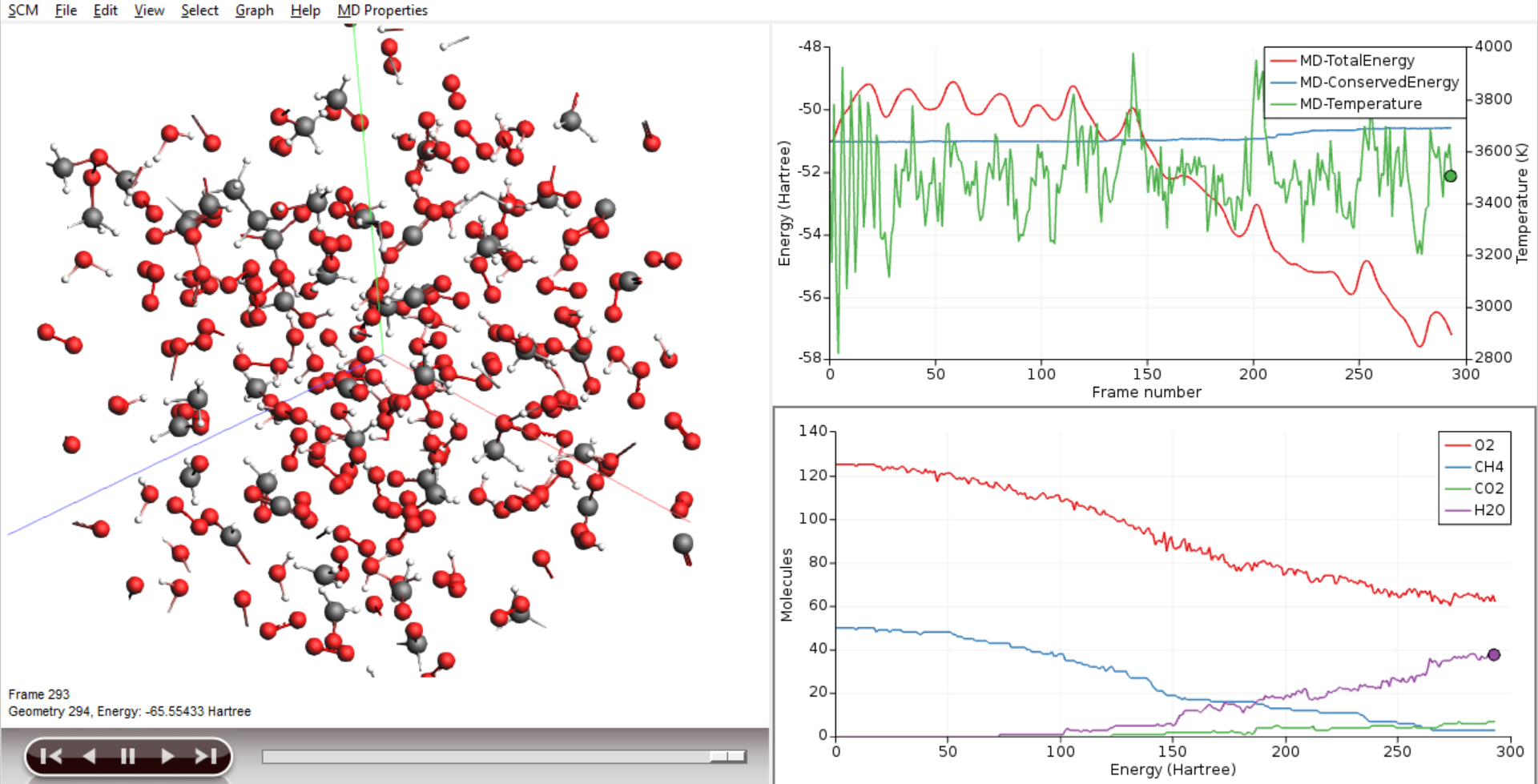
Tip
You can drag the legend in the plotting area around with the mouse
You can put one of the curves on a different axes if you wish:
- Click once on the curve showing the number of CH4 molecules, this makes it the ‘active’ curveUse the Graph → Curve On Right Axes command

Clicking on the curve also had two other effects (besides making it the active curve): you jumped to the iteration in the movie corresponding to the point where you clicked, and the molecules that belonged to that curve are selected.
Flying to the selection also makes it easier to spot them:
- If you have no CO2 curve yet: close the Molecule Fractions window, and use the Properties → Molecule Fractions command again to add a CO2 curveIf no CO2 yet, wait until the calculation has finished and try again (remember to close the Molecule Fraction window and open it again to refresh it)
To see the CO2 molecules clearly, we will switch everything but the CO2 molecules to wireframe.
Tip
The visualization style in the View → Molecule command applies to the selection only, if any
- Click in empty space so nothing is selectedUse the View → Molecule → Wireframe commandClick on the curve showing the CO2 productionUse the View → Molecule → Balls And Sticks to view the CO2 molecules more easilyUse the View → Fly To Selection command a few times

When you now go forward or backwards in time, it is easier to see how the reactions actually take place. Note that the atoms remain selected, even if they are no longer part of a CO2 molecule. In a similar way you can focus on H2O produced:
- Switch the CO2 back wireframe: View → Molecule → WireframeClick on the curve showing the H2O productionUse the View → Molecule → Balls And Sticks to view the H2O molecules more easilyUse the View → Fly To Selection command if needed

Another tool to see what is going on is hiding molecule that are not of interest. In this example, let’s hide CH4 and O2:
- Clear the selection by clicking in empty spaceSwitch to wireframe: View → Molecule → WireframeIn the molecule fractions dialog, uncheck the second check box for CH4 (in the Show column)In the molecule fractions dialog, uncheck the second check box for O2 (in the Show column)

- Use the molecule fractions dialog to show all molecules againWait until the calculation is readySelect the CO2 curve (click on it)Move it to the left axes: Graph → Curve On Left Axes

There is another tool to focus on a region of interest, by showing only some selected part:
- View → Molecule → Ball ; sticksSelect an atom somewhere in the centerUse the Select → Within radius … command, and select all within 5 AngstromView → Show Selection OnlyClick in empty space to clear the selection

- View → Show All to see everything again
Step 5: Analyze it: Create a reaction network¶
In this part of the tutorial we will analyze our methane trajectory in more detail by creating a reaction network using the automated reaction event detection (ChemTraYzer) in AMSmovie.
Note
A ChemTraYzer analysis can currently not be performed on periodic systems, e.g. surfaces. If the molecules created during the reaction exceed a size of ~50 atoms, the 2D depiction of the species can fail. If this happens, it is still possible to obtain results when running the analysis from the command line. See how to run on the command line .
- MD Properties → Reaction Event Detection

The dialog window coming up displays the settings for the reaction event detection. It consists of two steps, a processing and an analysis step, both of which have different settings. In short, the processing step will determine which species are formed at what time, while the analysis step creates a reaction network and calculates the rate constants.

For now, we just stick to the default values:
- Click on Process
this will start both the processing and the analysis step. Depending on the size of the trajectory this can take some time (a few minutes on a modern desktop computer). You can follow the progress messages in the bottom right of the dialog window. Once the message “Ready” appears, the calculation is finished:

In the bottom panel of the ChemTraYzer dialog you will now find the total number of reactions and species as obtained during the processing step and the filtered number of reactions and species as obtained during the analysis step.
- Click on Browse
Your Browser will open and display an overview page of the ChemTraYzer results:

Tip
Make sure your computer opens .svg files in your browser (not in some text editor).
On a Mac one can do this by selecting the .svg file in the Finder, Get Info, select the application to use, and click the Change All… button. The .svg files for this example are located in the Methane.results/scmtrayzer folder.
Step 6: Analyze it: Browse a reaction network¶
The results can be explored by clicking on molecules or one of the links on the top right next to the SCM logo. You can use the same links or your browser history (\(\leftarrow\)) to return to a previous page.
Let’s start by taking a look at the reactions of one of the most reactive species, e.g. the methyl radical:
- Click on the image of the CH3 radical listed under “Top 5 Reactants”
You will see the results for the methyl radical, i.e. all reactions it is involved in:

Clicking again on the central species will now direct you to the Cartesian coordinates. Depending on your browser settings these will be displayed by an external program, e.g. an editor, or inside your browser:
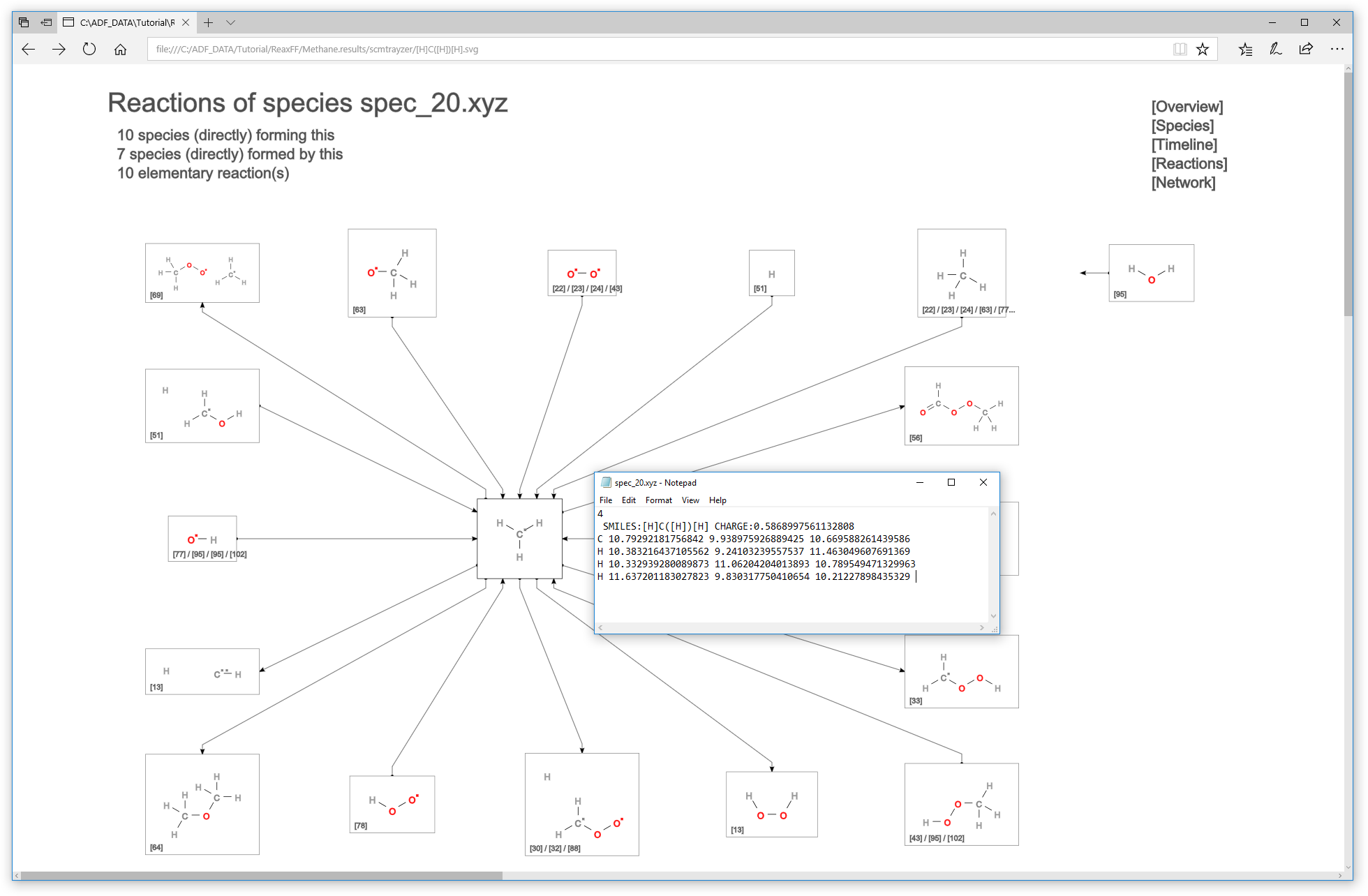
The arrows connecting the species indicate whether they contribute to the formation or decrease of the central species while the numbers label the index of the corresponding elementary reaction.
Note
If you are using Microsofts Internet Explorer (IE10 or IE11) you will only see lines instead of arrows. This is due to a bug in Internet Explorer that is unlikely to be fixed. Using any other browser will resolve this.
For example: The O2 molecule contributes to the formation of methyl radicals via elementary reactions #36, #62 and #64:
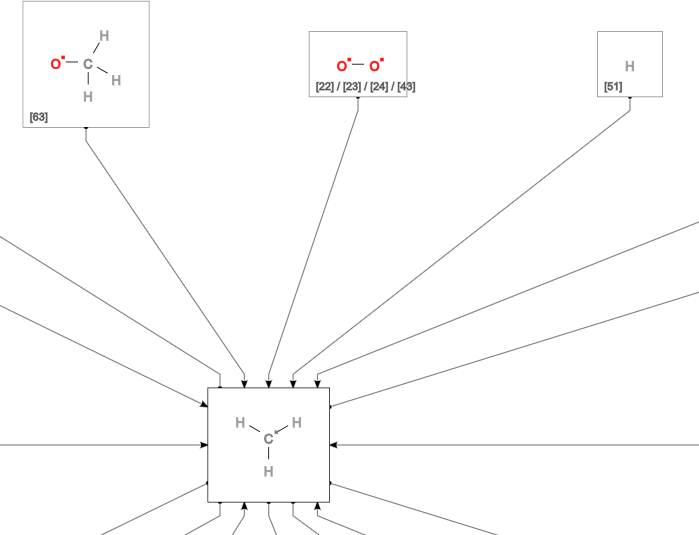
If you scroll down you will find a listing of all elementary reactions the methyl radical is involved in. The label “Total Flux” indicates how often the reaction was observed during the simulation time whilst the rate constant refers to the forward reaction:
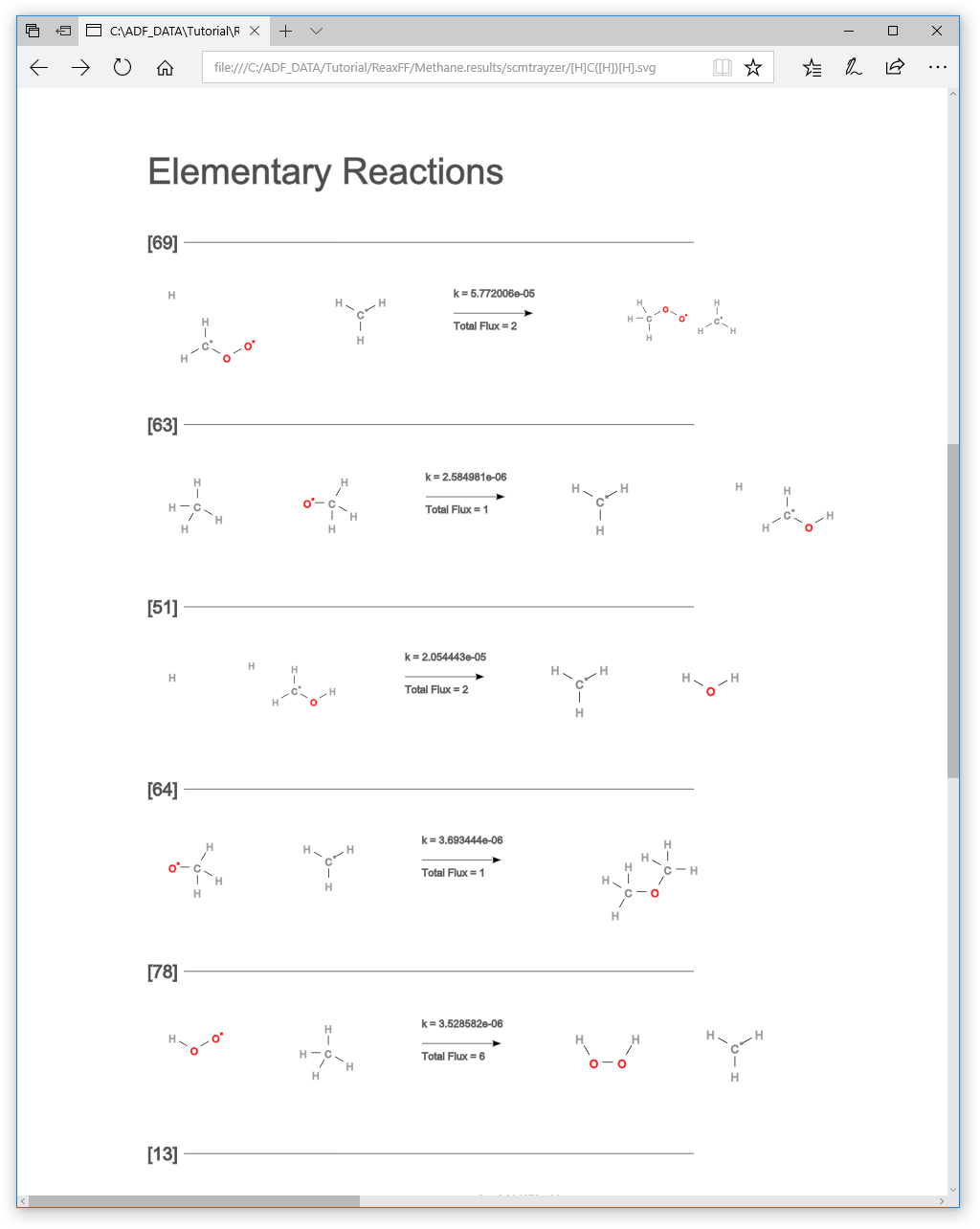
Next we take a look at all species found by the reaction detection
- Use your browser (\(\leftarrow\)) to navigate back to the overview pageClick on [Species] next to the SCM logo on the top right
You will see a list of all species with some information on when the species was first observed, how many reactions it is involved in and finally the maximum concentration of the species:

Clicking on [Reactions] will show a similar overview for all elementary reactions, while [Timeline] will bring up a timeline visualizing the species’ first appearances during the trajectory.
You can also take a look at the complete reaction network:
- Click on [Network] on the top right

A graphical representation of the adjacency matrix, illustrating the connections between the species, is shown. In this matrix, a column represents a “forming” relation, while a row represents a “formed by” relation. For example, methanol (CH3OH, 1st column) forms water (H2O, 2nd row), while methanol itself can also be (re)-formed or formed by, e.g. hydrogen peroxide (HOOH, 11th column vs. 1st row).
While scrolling in and out of the adjacency matrix, you might have already realized that even our medium sized reaction network can be quite confusing and hard to oversee. However, the amount of species can easily be reduced by applying filters to the reaction network as described in the next section.
Step 7: Analyze it: Filter a reaction network¶
For now, let’s assume we are interested in oxidized carbohydrates only and want to filter the reaction network due to that constraint:
- Bring up the ChemTraYzer dialog from AMSmovieSet the Flux Threshold to 2Select O from the Restrict Element Count menu and enter 1-2Select O from the Group Species by Atom dropdown menuClick Analyze and wait for the analysis to finish
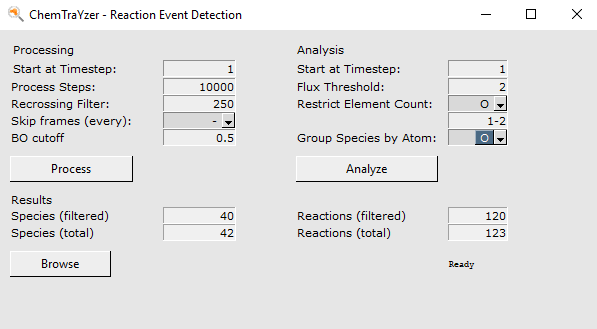
Note that we do not need to re-run the processing step but can now run the analysis directly. By choosing the above settings we will only consider elementary reactions that occur at least twice (“Flux Threshold = 2”), contain species with one or two oxygen atoms (“Restrict Element Count”) and sort the species according to the amount of oxygen they contain (“Group Species by Atom”).
Once the analysis has finished:
- Refresh your Browser or click Browse in the ChemTraYzer dialog
The species displayed in the list of species all contain at least one but not more than two oxygen atoms and are sorted:
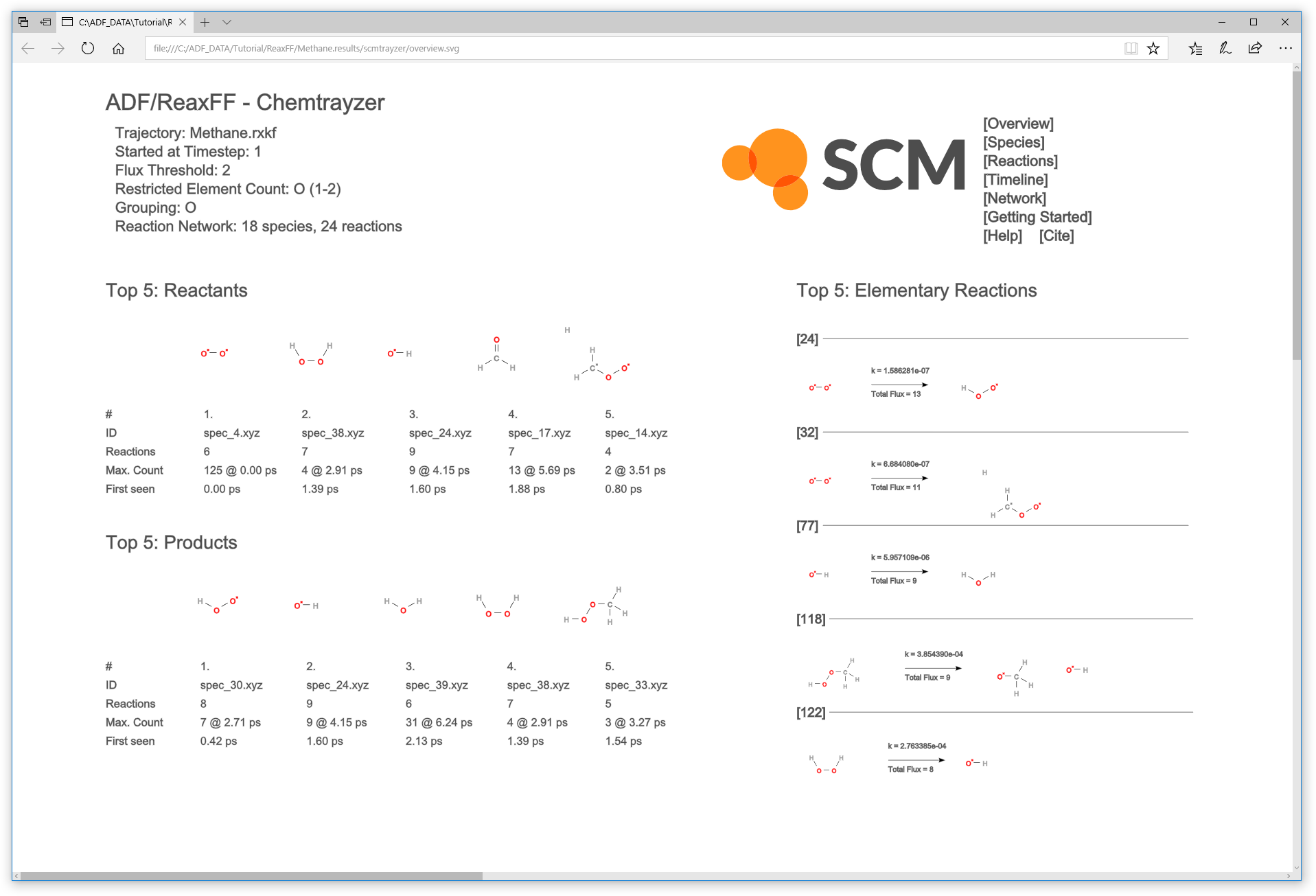
To prepare for the next tutorial, quit everything:
- Bring the AMSjobs window to the foregroundUse the SCM → Quit All command to close all windows for this job
Troubleshoot¶
In some situation a graphical representation of the reaction network cannot be created. Known cases include the combustion of large molecules for which no meaningful 2D images can be created, periodic systems such as surfaces or very large trajectories. If one is willing to sacrifice the graphical representation, it is often still possible to extract plenty of information with the help of the command line version of ChemTraYzer. In particular large trajectory files can be handled efficiently. How this is done, is explained in the ChemTraYzer entry of the ReaxFF manual .




